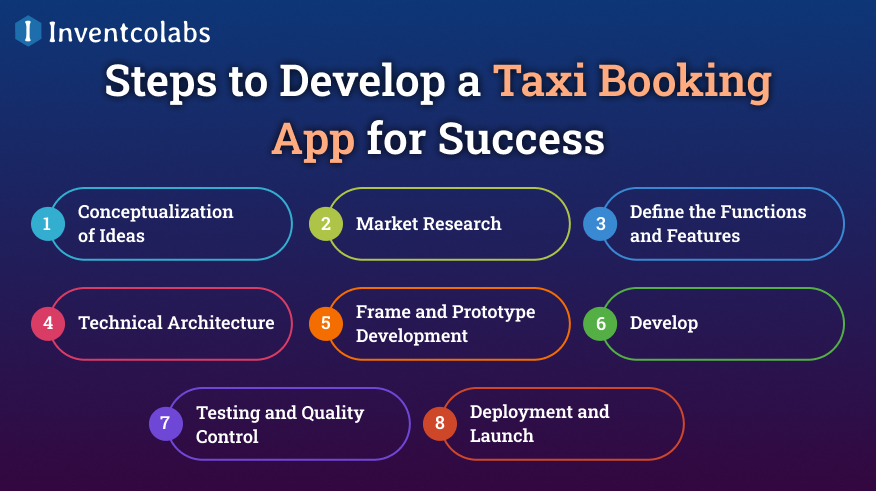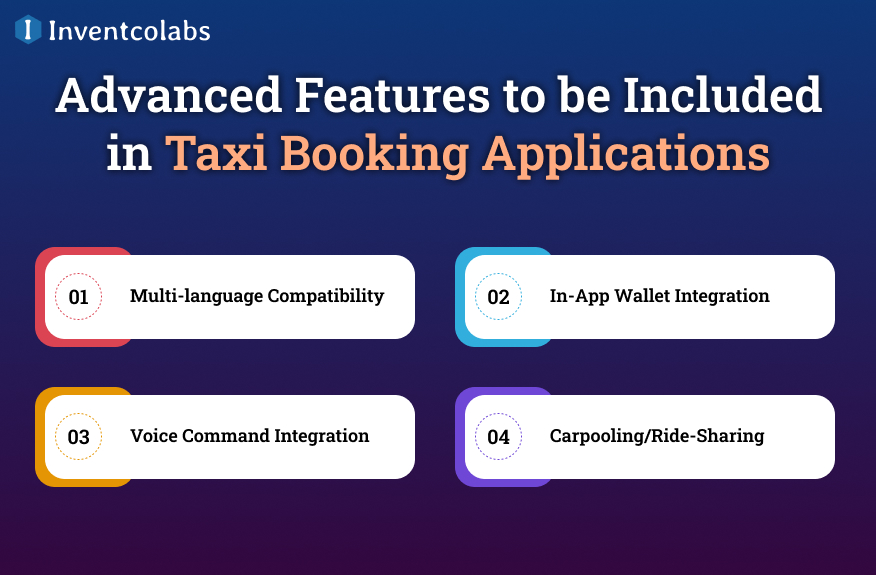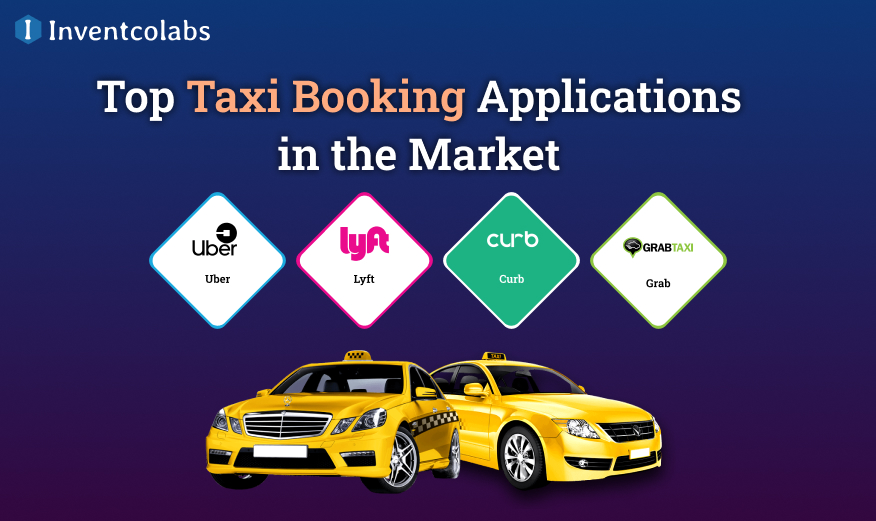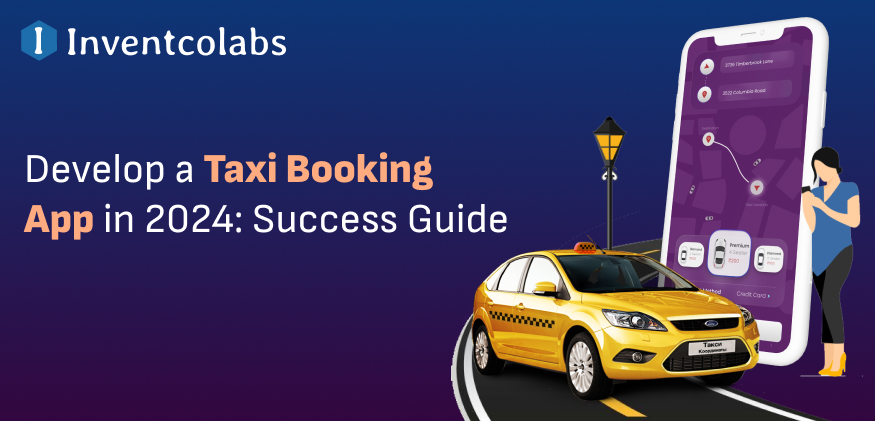The use of smartphone apps is growing daily due to the growing accessibility of the internet and technology. There are many taxi booking applications accessible on the Play Store, and there’s always room for the most effective ones! Since the demand for online taxi bookings is growing, many taxi firms are keen to establish their presence in the market.
These days, people are widely using online transportation services, which have created a variety of new improvements. By 2027, more than 1.45 billion people across the globe will use taxi booking online services. Technology is improving each day, making our lives simpler by allowing us to order food items or grocery items online.
The taxi booking application is a great tool used by various users worldwide. It features a highly appealing business component that adheres to the rules for taxi app start-ups to begin operations. This blog post will offer complete guidelines for taxi booking app development with benefits, features, and other specifics. Read this blog for all the information.
What Are Taxi Booking Apps?
Taxi or cab booking applications are digital platforms that allow users to arrange and purchase rides from drivers’ fleets that operate their own vehicles or taxi service companies. They are available on the Android and iOS platforms or separately.
The application for booking taxis quickly connects a user with the driver nearby, which is the underlying principle of this type of technology. In general, passengers are able to follow the driver’s location and time of arrival or view estimated trip fares and the time of arrival prior to making the booking. Users can also select the vehicle type or other preferences specific to their travel.
The concept behind this kind of app is called ride-sharing or ride-hailing services. It is a change from the traditional method of hailing taxis on the streets or calling a taxi dispatch center to request one.
Explore More: Uber-like Taxi Booking App Development Company: App Ideas to Consider in 2024
Taxi Booking App Landscape Overview
In 2024, a variety of major trends will influence the future development of taxi booking apps. Understanding these trends is vital for companies.

>Sustainable and Eco-Friendly Rides
The trend towards sustainability is causing an increase in eco-friendly transportation, as hybrid and electric vehicles are gaining prominence in taxi fleets. Apps that facilitate the reservation of eco-friendly vehicles are growing in popularity, with a focus on the environmental aspect.
>AI and ML
Machine learning and artificial intelligence transform taxi booking applications, improving personalization and operational efficiency through predictive analytics, AI chatbots, and real-time routing optimization.
>Enhanced Security
As the number of digital transactions increases, advanced security measures such as biometric authentication, complete encryption, and payment processors are increasingly essential in establishing trust and keeping customers.
>Blockchain for Transparency
Blockchain technology is expected to bring efficiency and transparency, offering safe transactions and the possibility of decentralized services, which will increase transaction efficiency and cut costs.
>Ride-Sharing and Pooling
Pooling and ride-sharing are growing as environmentally friendly and affordable transportation options that appeal to eco-conscious and budget-conscious users with affordable transportation and reduce congestion in traffic.
>User Experience
Enhancing user experiences by incorporating options like a preference for drivers and custom options is essential to increasing customer satisfaction and loyalty.
>Multiple Payment Systems
The variety of payment methods, such as e-wallets, transfers to banks, and cryptocurrencies backed by blockchain technology, sets new standards in terms of convenience and security.
>Government Regulations and Partnerships
The changing regulatory landscape and the partnerships with government agencies aim to improve urban mobility, support environmentally friendly vehicles, and guarantee security and fairness. This has led apps to evolve with standards-compliant features.
>Expansion of Services
Beyond the basic taxi booking app, they have expanded their offerings to include food delivery, parcel delivery, and other services. This diversification opens new revenue streams and increases users’ engagement by making an app a complete solution to meet multiple requirements.
These trends suggest that innovation that focuses on the user and is environmentally friendly is important for taxi apps to succeed. Mobile app development companies that stay on top of these changes and continuously improve their apps will thrive in the ever-changing digital landscape.
Categorizing Taxi Booking Applications
One of the important aspects to be established when designing the taxi booking application is the business model you would like to adhere to.
The business model guides the process of developing apps and directly influences the taxi booking app development cost.
There are two kinds of taxi applications: dedicated taxi booking apps and taxi aggregator apps.
>Dedicated Taxi Booking App
This model is ideal for businesses with an established taxi company. They’d have an array of taxis and drivers.
A taxi booking application allows the taxi company to go to the web, making it easier for customers to connect with their taxi services.
Additionally, it provides the possibility of reaching an even larger customer base.
The transactions take place directly between the taxi services without middlemen.
Customers input their pick-up location, preferred vehicle, and other information. The taxi service dispatches drivers to drop the customers off at their preferred locations at predetermined rates.
>Taxi Aggregator App
This is the type of model that has been embraced through taxi-booking apps such as Uber or Ola.
The app functions as a platform for taxi companies or taxi owners to register their vehicles and provide services to customers.
Taxi aggregators work with taxi drivers to provide transportation.
Usually, the aggregators charge a convenience fee to provide their service.
This model is possible to implement in two ways: easy and on-demand
Easy Taxi Reservation App: These apps don’t require a server.
Taxi drivers can be solicited using just one app. Users can make a call and request taxis from the app.
On-Demand Taxi Booking App: This application requires an internet connection to run. Two apps are required here—one for passengers and the other for drivers.
The taxi business on the internet is growing rapidly thanks to applications that use these different business models to expand their taxi services.
It is anticipated that in 2025, the annual increase of the worldwide ride-hailing market will be $126,521 million! This implies that now is the perfect moment to invest in the development of an online taxi service.
Explore More: Car Parking Finder App Development – Full Guide
Top Reasons to Build a Taxi Booking Application in 2024
The demand for taxi booking services has been expanding for several years.
- The taxi and ride-hailing industry is expected to earn US$165.60 billion in revenue in 2024. The market is expected to increase at a rate of 6.83 percent for the following four years and eventually reach a CAGR of 2024-2028.
- According to research, the taxi booking app market is expected to grow quickly. The estimated worth of apps for taxis by 2026 is $150 billion.
- Uber is one of the most well-known taxi ride-hailing applications. It made between $36.5 billion and $37.5 billion, as compared with Street Account’s projection to earn $36.5 billion and an adjusted EBITDA (EBITDA) of $1.18 up to $1.24 billion.
- The market’s growth rate is expected to be 5.03% (2023-2026), and the size will be $390 million in 2026.
- Also, the number of people using the sector is expected to grow to 1666 million in 2026, indicating a need to expand taxi booking app development.
- Users are now around 20 percent (2023) and are expected to reach 20% by 2023—an anticipated increase of 21.1 percent in 2026.
- If we look at the number of users using these programs and their utility, the average income per user is about $205.92.
- The ride-hailing and taxi categories could account for approximately 50% of the total income by 2026.
- These figures are just estimates. Actual outcomes could exceed them due to developments and future scenarios the world may face within the next few years.
Steps to Develop a Taxi Booking App for Success
To create an easy and enjoyable experience for passengers and drivers, creating an app for booking taxis consists of various crucial processes.
These are the steps:

>Conceptualization of Ideas
Determine your app’s principal objective. Determine the market you want to target, the distinguishing factors that will make your app stand out from other apps, and the features that appeal to users.
>Market Research
Study user preferences, rival applications, and the taxi business in particular. Know the market’s demands, price structure, and technological advancements. To simplify the process and increase efficiency, you can seek assistance from taxi app developers. They’ll conduct market research and provide the most effective solutions to your requirements.
>Define the Functions and Features
The features that your app can provide. This might include ratings, profiles of drivers, reviews, real-time tracking, trip planning, payment integration, and many more. It is essential to follow this procedure to build an on-demand taxi booking application.
>Technical Architecture
Architectural design for applications considers various elements, such as the structure of databases and servers, server setup, APIs, and the stacks of technology you’ll be using (such as hybrid frameworks, native development, or toolkits, for example).
>Frame and Prototype Development
Wireframes and prototypes are necessary to illustrate the application’s User Interface (UI) and user interface (UX). They aid in improving usability and appearance before the development process begins. If you’re working on an application that can be downloaded on demand, make sure you take this step.
>Develop
Hire an on-demand taxi app development company to develop applications with wireframes and prototypes. The front, the front end (user interface), and the back end (server-side logic) should be coded to provide functions. Integrate check-in, booking of cars, driver assignment, check-in, and payment processing elements into your daily routine.
>Testing and Quality Control
Examine the application carefully to identify glitches, flaws, and usability issues. Examine the application’s functions, integration, and acceptance to ensure that drivers and passengers have a pleasant experience.
>Deployment and Launch
After you have tested thoroughly, the app can be published to the Play marketplaces (such as the Apple App Store or Google Play Store). To keep users interested in the app, promote it via social media. To further develop the app, monitor its performance, and gather user feedback.
For an app to be successful in booking taxis, it requires constant maintenance of updates, upgrades, and enhancements based on user feedback and changing market trends. Also, ensure that your app complies with all privacy laws or regulations.
Explore More: Success 2024: How Dubai is Revolutionizing the Car Wash Business in UAE?
Advanced Features to be Included in Taxi Booking Applications
A more sophisticated app requires extra features that aren’t normally available in a simple one. The possibilities with technology are limitless, and taxi app developers can experiment with their ideas to stand out.

>Multi-language Compatibility
If you are targeting a global market, creating taxi apps that support different languages is essential. Travelers who are not native speakers can choose the app’s language or the most convenient one.
>In-App Wallet Integration
Modern taxi companies today offer an in-app wallet feature. With this feature, customers can deposit money into their accounts wallets and then pay for rides without paying cash or entering credit card numbers each time.
>Voice Command Integration
A voice command feature allows drivers and passengers to communicate through the taxi reservation app using natural technology for processing language (NLP) technology. It will result in a more user-friendly and convenient user experience. For example, customers can ask the app for an appointment by speaking the request out loud rather than typing it.
>Carpooling/Ride-Sharing
With this option, people traveling in the same direction can share a ride and split the cost. Drivers can pick passengers up in a way that doesn’t impact the drop-off location of the other passengers. This type of group ride helps customers cut costs and reduce waiting time for everyone who tags along. From a sustainability standpoint, carpooling could help reduce congestion on the roads and carbon emissions.
Explore More: How to Develop A Ride-Sharing App? Key Features & Cost
Top Taxi Booking Applications in the Market
With fierce competition in the ride-hailing business, it’s normal to seek the guidance of its leaders when considering the best way to create an app for taxis. Uber, Lyft, and Grab control the taxi market, so it’s important to carefully examine their strategies and methods.

>Uber
UberCab, founded in 2009 by Garrett Camp, was the first ride-hailing system. Uber is currently in 630 cities and is expanding. One way that this expansion is happening is through the acquisition of associated services. In 2019, Uber paid $3.1 billion to purchase Careem, a Middle Eastern taxi booking app.
Uber has changed, and the costs related to its development are hard to estimate. According to NextWeb, Based on Uber’s initial funding rounds, the cost of developing an Uber app, which comprises taxi driver apps as well as an app for riders, will be anywhere between $1M and $1.5M.
The development of Uber’s taxi app required a lot of money. The initial investment was around a million dollars, sourced from nine investors. Think about what this means: Uber Technologies has raised more than $22 billion of funds to develop its taxi booking app over the last nine years.
>Lyft
The Lyft app was introduced in 2012, just a few months after Uber. It was initially known as Zimride, an inter-city ridesharing service that connects passengers and drivers through Facebook.
With around 200 major cities across the United States, Lyft’s taxi booking service is considered an exact rival of Uber. Lyft’s distinctive feature is its rating system, which guarantees that only the most skilled drivers are employed. Furthermore, it is worth noting that the Lyft taxi app is insured with one million dollars of liability insurance. In addition, Lyft is thought to be more affordable than Uber, which means you will have to pay around $12 as opposed to the $16 cost of Uber.
>Curb
Curb is a different taxi booking service located within the United States. Its collection of more than 50,000 taxis and hired vehicles is spread throughout the 65 US cities. Customers have three choices when booking rides: “ride now,” “ride later,” and “pair and pay.”
The major difference that separates Uber and Curb is that the main difference between Uber app and the Curb application is that Curb’s app Curb app doesn’t offer the high-priced surge which Uber is accused of. Surge pricing refers to adjusting prices based on the demand at a specific time. This means a ride with Curb is less expensive, and the taxi app is the most eco-friendly service. Alongside the fee for a trip, customers are also paid a $1.95 commission.
>Grab
Grab is a well-known taxi booking application in Southeast Asia, with Singapore, the Philippines, Malaysia, Indonesia, Thailand, and Vietnam. The taxi app provides various travel options and payment choices (a card or cash, as well as Grab credits). In addition, Grab also provides numerous services for food and other item deliveries that are extremely well-liked by restaurants and sellers.
Explore More: Taxi Booking Mobile App Development – Full Guide
Cost of Developing Taxi Booking Application in 2024
A basic taxi booking app cost can range around $25,000 and $50,000 for one platform. The process of creating an app that works on both iOS and Android will cost you anything between $50,000 and $100,000.
In addition, sophisticated functions, such as live ride updates, in-app communication, fare calculation, and different payment methods, could impact the overall cost.
It is important to remember that these are only ballpark cost estimates, and the final cost could be significantly different based on the specific needs of your project. If you’re trying to obtain an accurate estimation, you can contact us to hire dedicated developers to take care of your requirements and give you a cost estimate in line with your requirements.
The Key Takeaway
This post has guided you about how to create a taxi booking application in 2024. It requires a thorough strategy that includes market research, selection of technology, user experience design testing, integration of features, launch, and continuous monitoring and improvements. Therefore, it is crucial to identify your market and distinctive selling proposition, select the appropriate technology stack, create an intuitive interface, incorporate important features, rigorously test the app, and continually review and improve its performance.
Are you planning to develop an app allowing taxi booking for your new or existing business? Make your taxi business an online venture with an innovative app that can maximize its potential. Inventcolabs, a leading taxi booking app development company recognizes the issues you will face in a highly competitive market and the need to keep an edge over your competition. Therefore, our app developers for taxi booking applications are masters in creating robust, feature-rich, easy-to-use taxi booking applications that can help you streamline your business.





